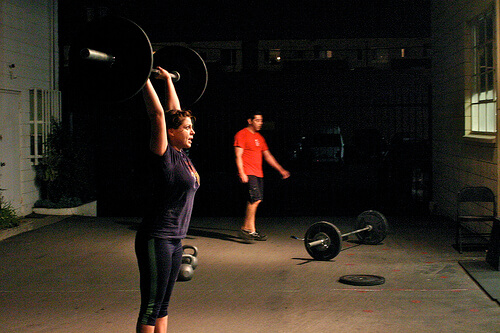Heathly cooking fats and oils
Sunday, February 12, 2012
Mobility:
10 Pvc dislocates
2 minute keg drill
10 Pvc dislocates
Ankle mobility with band
Warm-up:
2 Rounds
10 Overhead squats w/Pvc
10 Pull-ups (strict)
10 Push-ups
10 Ghd Sit ups
10 Back extensions
Samson stretch
10 Overhead squats (light load)
10 Push press
10 Pull-ups (kipping)
10 Ghd sit-ups
10 Hip extensions
Samson stretch
Workout:
Complete as many rounds as possible in 15 minutes of:
135 pound Push press, 7 reps
135 pound Overhead squat, 10 reps
15 GHD sit-ups
Cool down:
Cat on box stretch
Pigeon
Seated pike
10 Wall extensions
Before I started eating paleo, I really used only one kind of oil while cooking: vegetable oil. I ask myself now, “What was I thinking?” Well, I was using what my mother used and what her mother used along with every other mother in the 50s. Canola, margarine and vegetable oils were the new “Heart Healthy” oil alternatives back then. Today, I’m going to share with you the REAL 4-1-1 on safe cooking oils and fats that will keep EVERY part of you healthy.
The details:
Saturated fats are more STABLE than unsaturated fats. Meaning, the chemical structure of saturated fats cannot be easily damaged by light, heat and air. Unsaturated fats are the complete opposite. Light, heat and air damage the natural chemical make-up of the fat. In olive oil’s case, high heat completely depletes the oil of its naturally awesome nutritional qualities. Once this happens, the oil, in some ways, becomes toxic. Ever wonder why your high-quality olive oils are sold in a dark green or brown glass? It’s to keep light out, similar to why beer and wine is thought to be better stored in darker bottles. In the same sense, coconut oil doesn’t go bad or smell rancid from sitting out on the counter without a lid on it the way vegetable, corn, or soybean oil will. Air oxidizes those unstable oils and makes them rancid.
Examples:
Canola oil, for example, is an unsaturated fat that is commonly used in a lot of commercial kitchens. It is made in mass quantities, but unfortunately it is very unstable, unnatural and oxidizes VERY easily. It becomes extremely rancid when exposed to air. The chemical structure of unsaturated fat is delicate like a flower, so when you open the bottle and it’s exposed to an environment different than what’s inside the bottle, its chemical structure changes. Don’t ever use this in your kitchen, EVER!
Olive oil is very delicate when it comes to heat. Hence, it’s not wise to cook on high heat when using olive oil. Low, low heat is more favorable so that the chemical structure can remain in tact and your body can absorb all of its delicious nutrients. Olive oil is best used for cool dishes or as a dressing for salads.
Coconut oil and animal fats are good STABLE saturated fats. Their chemical structure does not easily change when heat is applied. You would have to use very high heat for a long period of time to see any change with this type of fat. Coconut oil and animal fats are far more favorable because their chemical structures remain in tact during the cooking process. The body then recognizes and digests them properly.
Oils that have gone rancid or have oxidized are not recognized in the body as natural. The body literally thinks that you have just ingested a toxin. Our bodies store toxins and plastic-like foods in our fat cells instead of readily digesting them. This type of storage leads to that pesky irritant you hear about all the time in the gym: INFLAMMATION! Those inflamed fat cells are where chronic diseases, weight gain, weight loss resistance, feelings of fatigue, joint pain, and lethargy all go to hang out.
Now that you are a whiz-kid when it comes to healthy cooking fats and oils, go forth and be awesome in your kitchen. School the next vegan you see picking up some soybean oil at Whole Foods and then do a couple burpees in celebration of your newfound wisdom.
Click here for a handy little chart that I keep in the kitchen. It’s a quick guide for the oils that are best and oils that shouldn’t be in your cupboards at all.
If you want to be further enlightened about the dangers of canola oil (which is unfortunately used in most restaurants and Whole Foods kitchens) watch this video. It takes you through the rigorous process of bleaching, de-gumming and deodorizing the oil. I don’t know about you, but I don’t see any benefit of putting oils in my body that need to be bleached and “de-gummed”. A good general guideline for safe and nutritious oils is to stick to the natural ones that are not altered in any way before cooking.
As always, if you have any questions regarding this information or would like some additional reading materials, please don’t hesitate to email me at jamielynn.gilbert@yahoo.com.
















